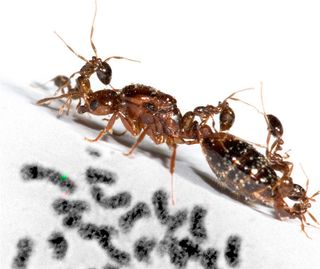Fire Ant Monarchy Ruled by 'Social Chromosome'

Whether fire ants bow to one queen or accept many rulers depends on one long strand of genes, a new study finds.
The gene sequence is the first "social chromosome" ever discovered, according to study researcher Yannick Wurm of Queen Mary, University of London, who called the DNA sequence a "supergene."
"This was a very surprising discovery," Wurm said in a statement. "Similar differences in chromosomal structure are linked to wing patterns in butterflies and to cancer in humans, but this is the first supergene ever identified that determines social behavior."
Choosing queens
The fire ant Selenopsis invicta is one of many fire ant species known for nasty stings. The species is native to South America and invasive elsewhere. One of its odder traits is a particular flexibility about its social structure. Some members of the species live in colonies with a single queen, while others tolerate hundreds of queens. [Gallery: Stunning Photos of the World's Ants]
The new genetic analysis, published Thursday (Jan. 17) in the journal Nature, finds that a sequence of genes on a certain chromosome determines which social arrangement is acceptable to the ants. Much in the same way that the human sex chromosomes vary between X and Y, the ant chromosomes vary between B and b.
If all the workers in a colony carry the B variant only, they will accept a single queen that also carries only the B variant (marked as BB, because the chromosomes come in pairs). But if some workers in the colony carry the b version of the chromosome, the colony will accept multiple queens — but only those queens with a mismatched "Bb" set of chromosomes.
Sign up for the Live Science daily newsletter now
Get the world’s most fascinating discoveries delivered straight to your inbox.

Smelly queens?
The chromosomal differences have been linked to a number of anatomical differences in the ants, Wurm and his colleagues wrote, from the queen's fecundity to the size of male workers and the structure of their sperm. These differences could explain how the ants "know" what sort of monarchy to accept.
"Odor is likely involved," Wurm told LiveScience. "We know the queens smell different."
The two different genes may also confer their own advantages. BB queens mate and disperse to their own colonies when they reach maturity, making them good at invading new areas, the researchers wrote. Bb queens join others near their maternal colony and, working together, produce more workers overall. This might make them more successful in previously colonized areas.
Wurm and his colleagues plan to dig deeper into the chromosome to find out which of the 616 genes in the social sequence are responsible for the differences between ants. They also hope to find out if similar sequences play social roles in other species. And the differences aren't just academic. The fire ants have spread into the southern United States as well as Australia and China, where they are major pests.
"Our discovery could help in developing novel pest-control strategies," Wurm said. "For example, a pesticide could artificially deactivate the genes in the social chromosome and induce social anarchy within the colony."
Follow Stephanie Pappas on Twitter @sipappas or LiveScience @livescience. We're also on Facebook & Google+.

Stephanie Pappas is a contributing writer for Live Science, covering topics ranging from geoscience to archaeology to the human brain and behavior. She was previously a senior writer for Live Science but is now a freelancer based in Denver, Colorado, and regularly contributes to Scientific American and The Monitor, the monthly magazine of the American Psychological Association. Stephanie received a bachelor's degree in psychology from the University of South Carolina and a graduate certificate in science communication from the University of California, Santa Cruz.











